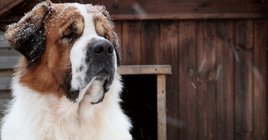Beautiful Photos Document How a Wolf and a Bear Spent Days Together
Published: 2025. 04. 26 - Photos: Getty Images Hungary • 5 minutes reading

Published: 2025. 04. 26 - Photos: Getty Images Hungary • 5 minutes reading

Finnish photographer Lassi Rautiainen has captured the unusual relationship between a wild bear and a wolf. Why unusual? The two species rarely get along, and in some areas can pose a serious threat to each other's lives. However, the female grey wolf and male brown bear seem to get on very well together, as their photos show.
The pair were observed by the photographer for ten days, during which time the animals regularly enjoyed each other's company, often between 8pm and 4am. Why a bear and a wolf can be “friends” is discussed below, and of course we show you the brilliant photos.
Lassi Rautiainen first spotted this strange pair in 2013, and watched them from a distance in the wilderness of Kuhmo, Finland, for 10 days. Wild animals tend to stick to their own kind for survival - although there are examples to the contrary; you can read about the other odd couple in the box at the end of the article. While bears live solitary lives, wolves thrive in packs. At first glance, the bond between these two species seems to upset the paper.
Although the reason for their friendship remains unknown, relationships between different species may have developed because for some reason they were left alone and this caused them trauma and stress. The photographer put it this way:
No one knows exactly how or why they became friends. I think maybe they were both alone, young and a bit unsure how to manage on their own. It's nice to share rare events from the wilderness that one would never expect.
The two young animals not only hunted together, but also played, fed and rested, which is a sure sign of two things: security and the comfort that comes from each other's company. In Finland the brown bear population is stable, while the grey wolf population is endangered. Both species are under strict protection, which allows them to form bonds naturally in the wild. Although they are not the same species, they are interdependent.
In 2024, National Geographic reported a strange case of a wolf pack in Yellowstone National Park, where a pack of wolves was observed on several occasions moving with a grizzly. According to national park officials, it is incredibly rare for a bear to stay with a pack for long periods of time, as wolves usually chase away uninvited grizzlies if they venture too close or the bear scares the wolves away from its territory. Experts say that while it may be heartwarming to think that the bear has become an honorary pack member, in reality food may be the most likely motive. After all, bears sometimes take the prey of wolf packs when they are hungry enough.
Grizzlies are more common in autumn, when they try to get as much food as possible before hibernating for the winter. This period is known as hyperphagia, when bears take greater risks to get more calories, such as stealing prey from wolves," explained Aimee Tallian, a scientist at the Norwegian Institute for Nature Research who studies wolf-bear interactions.
Wolves are likely to make similar judgements when deciding whether to chase a bear away - risking injury if it attacks back. Hungry bears will also often take food from other animals, such as ravens or pumas; sometimes they will simply lie on the carcass to claim it as their own.
Wolves and bears have lived and still live together in most of their range in the northern hemisphere. Wolves are primarily carnivores, considered apex predators, which means they are at the top of the food chain and their lifestyle has an impact on the whole ecosystem. In contrast, brown bears are omnivores, foraging for seasonally available food. As seasonal carnivores, they prey primarily on neonatal herbivores and also play an important role in the ecosystem. For example, they help seed dispersal through their droppings and, as ‘part-time’ apex predators, they also have a significant impact on herbivore populations.
The situation for bears and wolves is pretty even. While bears are much larger, wolves hunt and move in packs. Because of this, the competition takes much longer in their case; it's hard to tell which way the scales tip. But it is undeniable that interactions between top predators are an important organising force in the world. Competition between carnivores can stabilise ecosystem dynamics, and the whole complexity of large carnivore and scavenger communities can be linked to ecological resilience.
According to some sources, wolf numbers are increasing, especially in the Americas, and deer numbers are decreasing as a result. This is taking its toll on black bears. It is said that in these areas it is not difficult to find a wolf burrow full of bear fur. But the reality is that this habit of wolves has not yet been confirmed by any biologist.
Whether these are isolated cases or whether there is a larger problem developing is not yet clear. As the above shows, the relationship between bears and wolves is layered and complex. The imbalance can be generated by causes completely outside their control, such as human expansion and thus dwindling resources. We hope that more research will be done in the future to use the information gathered to help protect both species.
Follow us!
facebook instagram youtube spotifyRelated articles

Advantages and Disadvantages of Wet Food for Dogs: We Point Out Some Surprising Things
Health • 3 minutes
How to keep your dog safe outdoors during the cold winter
Care • 5 minutes
Is your dog's paw slipping too often on the floor? Here's what you can do to help
Care • 3 minutes
As the temperature drops, your dog's skin becomes more sensitive: how to care for it properly
Care • 3 minutes